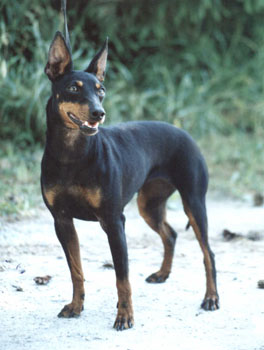The Manchester Terrier is one of the most popular dogs for travel companions due primarily to their size, temperament, and minimal grooming needs. The quintessential color for this short-haired breed is a combination of mahogany tan and jet black. The breed’s heritage and current standards can be easily understood as a fairly even mix of rat terrier and coursing hound, built on a toy-sized frame. We like to describe the breed as graceful in movement as it is cute in size. If you’re looking for a dog that’s small enough to be a lap dog, but has the motor and energy-level to go on fairly aggressive walks, then there’s an excellent chance the Manchester Terrier is right for you.

…HAVE EVERYTHING?
Size and Travel Options
Weighing 12 pounds or less, the Manchester Terrier is usually okay to fly in the cabin of a plane unless their height and health creates an issue. Standing 10-12 inches tall, the larger dogs in this breed may struggle to sit and stand comfortably an airline-approved carrier. This can be especially problematic if the dog develops patellar luxation. Along with knee pain, this condition may make it impractical to safely and comfortably travel with your pet.
With this in mind, so long as you look for a healthy and shorter Manchester Terrier, this breed should have little trouble traveling on pretty much any type of pet-friendly transportation including planes, trains, subway, and automobiles.
Personality as a Travel Companion
These dogs are typically easy-going around people, at least socialized from an early age. Along with their high-energy but easy-going temperament, they can learn tricks and put on quite a performance when called upon. In general, the Manchester Terrier is very smart and trainable, but these dogs enjoy pleasing their owners so positive reinforcement works best. Even still, it’s best to mindful of smaller pets and animals, especially hamsters, in case their prey drive comes out.
Moreover, it’s not just their energy-level that makes them good running and hiking buddies. Powerful hind muscles can propel this dog faster and longer than you might think, especially given its tiny frame. In terms of exercise, you should aim for a lengthy walk or play sessions everyday, but if you’re feeling sick or lazy, this breed is also fine sharing the occasional day on the couch with you.
An occasional brushing certainly doesn’t hurt, but mostly this breed just needs a weekly or activity-based bath to stay clean and dapper-looking. Likewise, the tight coat means that even the occasional shedding won’t overwhelm living spaces with dog hair, but there is enough shedding that this breed is NOT considered to be hypoallergenic.
Health and Longevity
There are a number of rare genetic disorders, most of which can be screened for. There is also work being conducted toward a new genetic test for juvenile cardiomyopathy. Again, like other toy breeds, patellar (knee) and ophthalmologic (eye) issues are also somewhat common. That said, the Manchester Terrier is one of the healthiest and longest-living breeds with an average life expectancy of 15-17 years.
Manchester Terrier Breeders and Adoption Centers
This breed was deliberately created as a cross between hounds and rat terriers in the mid-1800s when the people of Manchester, England wanted a two-in-one dog breed for rabbit-hunting and rat-killing. This combination has proven to have enduring appeal, including for people who are looking for a travel companion. You may be able to find a rescue or adoption center Manchester Terrier for $300-$600 to help cover the cost of the pet care facility or foster program. The average cost of a healthy puppy with strong pedigree from a reputable breeder is more likely to be somewhere in the neighborhood of $1000-$2,500.